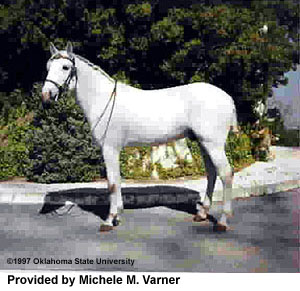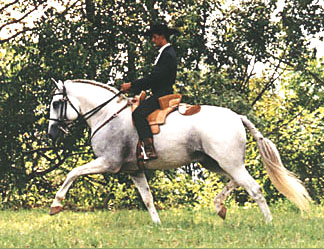

Lusitano


Introduction: This is a breed of national importance in Portugal, but while one source published in 1988 recognized it as the top Portuguese breed, it stated that it was clearly in decline. I hope this is no longer the case. If you have any comments or suggestions, please click here.
Names: Lusitano.
Origin: Portugal. The origins of this horse are uncertain but are probably similar to those of the Andalusian, which it resembles in some respects.
Breeding:
Description: A horse of the mesomorphic type, the Lusitano is slightly taller and lighter in build than Andalusian and has a good natural stance.
Back: Short and straight.
Chest: Broad.
Color: Gray, brown, bay or chestnut.
Croup: Rounded.
Ears: Small.
Eyes: Lively.
Head: Small, but with a rather pronounced jaw.
Legs: Forearm and thigh long; joints solid.
Neck: Quite thick, but well set-on and slightly arched.
Profile: Straight.
Shoulder: Muscular and correctly sloping.
Size: 15-16 hands (1.52 to 1.62 meters).
Tail: Low-set.
Withers: Clearly visible, but not too pronounced.
Temperament: Docile.
Features: Agile, easy to handle, and very frugal.
Uses: Used by army, on farms, and in bull rings. Riding horse, light draft, and light farm work. Historically it was used for military purposes and as a carriage horse. Today, although it is still used for light farm work, its most important role is in Portuguese bullfights, in which the rejoneador confronts the bull on horseback. The skill of this torero is in avoiding any injury to his mount.
Accomplishments:
Curiosities:
Profiles: Bussaco - Queen Elizabeth II's fine stallion, given to her by Portuguese President Salazar in 1957. At first, no one was sure what role the chestnut horse should play in the Windsor stalls. He was not then needed for breeding, and stallions are not always suitable as hacks. However, Bussaco was so gentle and willing that he was frequently ridden, sometimes by the Queen herself. He was beautifully schooled, quiet, and very responsive to the aids. Now (1970) on loan to a Gloucestershire stud, Bussaco has the unusual privilege for a stallion, of exercising himself alone in a paddock. He is no trouble, but exhibits a harmless, if scarifying display of high spirits, before being caught. Used with Anglo-Arab, Thoroughbred and show-pony mares, it is hoped that Bussaco's offspring will inherit their sire's bone, substance and charming temperament.
Conclusion: